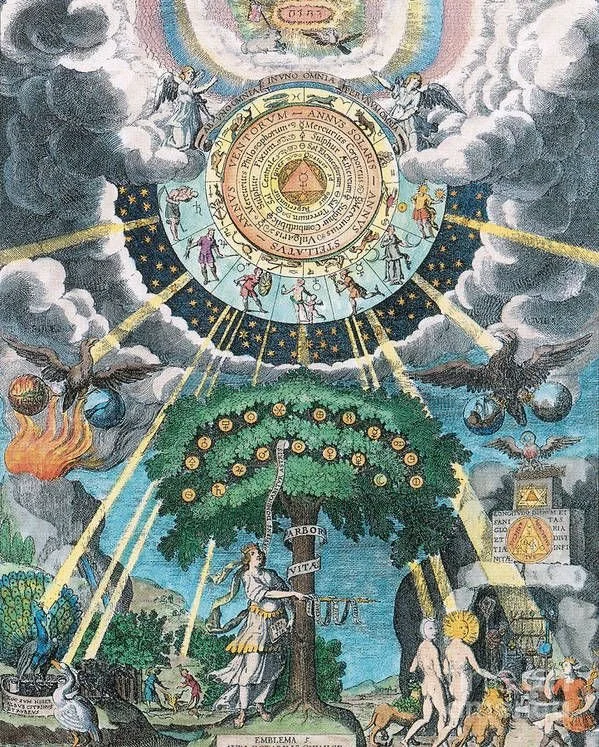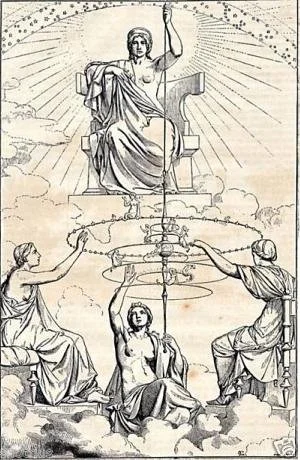Developing An Astrological Worldview
A serious study of astrology forces the student to come to terms with some of the most fundamental philosophical questions. It’s part of what I find so fascinating about the art. Of course, an astrologer could just arbitrarily decide to adopt a certain perspective without wrangling with the philosophical implications, or they can just say that the cosmos is some sort of solipsistic projection of their psyche into matter (“I create my own reality,” etc.), but I’m personally not satisfied with these approaches. In any case, the philosophical dichotomies presented by the study of astrology, such as fate vs free will, objectivity vs subjectivity, chaos vs cosmos, and a mechanistic vs enchanted worldview, demand some sort of consideration or synthesis in order to establish a sound theoretical footing.
A Paradigm Shift.
Over the last few years, I’ve personally had a series of pretty significant paradigm shifts in my cosmological perspective, particularly. These shifts occurred as a direct result of the foundational questions astrology asks, and having to make sense of them. I think cosmology is a great place to start if one is trying to adopt or erect a coherent worldview – that is to say, a worldview that checks the most boxes of plausibility, intuitivity and aesthetic worth – because it is literally the scaffolding of the entire philosophical edifice.
With this in mind, a primary question might be something like:
What is the nature and form of the cosmos?
My answer today (and this could be supplanted or subsumed by a superior paradigm tomorrow, as I find that maintaining flexibility and epistemic humility are crucial to the success of such a project) is rather anachronistic, to be honest, but I find it elegant and navigable. I picture the cosmos as a Great Sphere with an immanent Soul, within and without, permeating all that is and is not. It is animated and enchanted. The quantifiable and the qualifiable exist in reciprocity and complementarity.
Georeferentiality.
At the center is the Earth. I mean this in the georeferential sense (the Earth as the locus of human consciousness and point of observation), not necessarily the geocentric. For me, it doesn’t matter if the Earth revolves around the Sun or vice-versa. They’re both surrounded by the vastness of largely empty space – so who cares which revolves around the other? It really doesn’t change anything and neither perspective does any violence to astrology. Intuitively, it feels like the Earth is stationary and it is obviously the center of human experience (I guess this is some species of anthropocentrism, but I’m okay with that because astrology is, for the most part, an anthropocentric art).
For instance, imagine you’re looking at the solar system from above (north); the planets are revolving around the Sun, in counter-clockwise motion (secondary motion). Now take the pin out of the Sun and stick it in the Earth, making her stationary; this essentially says “you are here.”
Aristotelian ‘Natural Place’
The Earth, while permeated with Soul (her share of the Anima Mundi), is composed of matter which exists in various states: solid, liquid, gas and plasma. The four states of matter directly correspond to the four classical, Empedoclean “elements”: earth, water, air and fire. So, despite there being 118 (as of 2022) atomically weighted elements on the periodic table, the ancients were essentially correct in their estimation. The four classical elements are represented by the states of matter: earth is solid, water is liquid, air is gas, fire is plasma. And these elements/states, in the order listed above, are positioned in the order of their Aristotelian ‘natural place’ – a pre-gravitational theory. This stratification is intuitive because pebbles (earth) sink in a lake (water), and bubbles (air) rise to its surface, and fire is lighter than air. But change and corruptibility, as when the stratification is disturbed, exists in the elemental sphere, as elements tend to reject the imposition of the Platonic Forms and Ideas over time, thus leading to decay and death (see: Aristotle, On Generation and Corruption).
Primary Motion.
The Earth rotates on her axis once per day (this phenomenon is actually the cause of the day) in a counter-clockwise motion, when viewed from above the North Pole; this is the primary motion in astrology, which makes the stars and planets appear to rise in the east, culminate in the south and set in the west.
Following Aristotle and Ptolemy, the stars and planets are composed entirely of aether (the quintessence; “fifth element”), since they are unchangeable and incorruptible. They could not be composed of the mutable, sublunary elements. The planets and the stars also weave human and terrestrial fate and destiny, as in the Divine Plato’s “Spindle of Necessity” (Republic, Book X), hence astrology’s efficacy and applicability; the astrologer reads the celestial script.
The Spindle of Necessity
The Moon revolves around the elemental sphere of the Earth and forms a concentric, aetheric sphere around it. Below it is the sublunary (literally “below the Moon”), elemental realm; above it is the supralunary, celestial realm. Next is the sphere of the Sun, concentrically enveloping the spheres of the Moon and Earth. The Sun, however, has two spheres around it: those of Mercury and Venus (see: the cosmology of Tycho Brahe). This explains the inferior orbits of Mercury and Venus, and also their being tethered to the Sun (Mercury is never further than 28° from the Sun; Venus, no more than 47°), as they rise (orientality) and set (occidentality) with the star. The sphere of Mars envelops that of the Sun; the sphere of Jupiter envelops that of Mars; and the sphere of Saturn envelops that of Jupiter. Take a minute to picture that. So the planetary spheres are nested, like Matryoshka dolls, except for those of Mercury and Venus which are tied to that of the Sun, as explained above.
Tychonic Cosmology
Outside of the planetary spheres lies the sphere of the fixed stars and zodiac (sometimes called the “Ogdoad,” or the “Eighth”). We see the stars and zodiac as if they were all on a curved, concave plane, on the inside of a huge sphere. Yes, I know that there are great distances between the stars, in terms of their “depth,” and we encounter this in stellar parallax, etc. but, again, it doesn’t matter because the Earth is the locus of consciousness and observation and, either way, astrology is unscathed. The orderliness and intuitivity of the model take precedence here.
The Primum Mobile.
Outside of the sphere of the fixed stars and zodiac is “The One,” “The All,” the Primum Mobile, or whatever Ineffable Entity to which one theologically subscribes. Again, I tend to lean toward the Neoplatonic (and consequently Christian) hypostases, but that’s just me.
I personally believe that the cosmos is objectively real – not a solipsistic projection of my psyche, wherein I can “create my own reality,” as in the doctrines supporting The Secret and 20th century New Thought literature. Not only is it real, but it is absolutely possessed with entities: angels, daimones, djinni, etc.
So, if I had to name my particular composite cosmology, I would probably go with something like: Enchanted Tychonic Georeferentialism, with Hermetic and Neoplatonic overtones. It seems to work with my current studies, but it’s subject to change and modification.
In summary, I think it’s crucial to have a flexible-but-defined personal cosmology and one should be mindful of inconsistencies and address them as they arise. Astrology presents us with such problems – and many more – but that is a feature of the art that I really value, as it enhances my experience and understanding of the cosmos.




